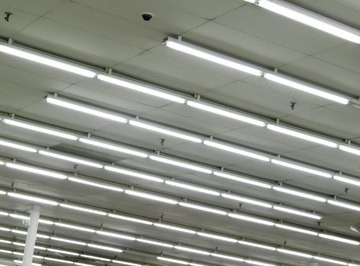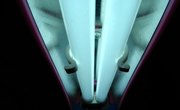
Once you notice the flickering in a fluorescent light bulb, it can be difficult to ignore the sometimes maddening effect. There are several factors that can make a fluorescent bulb flicker, and depending on the problem, you may be able to make a quick tweak that will help to silence your bulb and your brain.
TL;DR (Too Long; Didn't Read)
Several factors including faulty ballasts and starters, loose bulbs or even wiring problems can lead to flickering in fluorescent light fixtures.
Troubleshoot Flickering Bulbs
When you’re looking to stop your fluorescent bulbs from flickering, first check if it’s a simple fix. Make sure that your bulbs are screwed in tightly, as loose bulbs can cause flickering. If that doesn’t work, take a look at the bulbs. Fluorescent bulbs look like tubes, and they should appear bright throughout the entire tube. If you notice that a flickering bulb is dark near either end of the tube, it could be close to its end. Even if the bulb still gives off some light, the flickering could be a sign that it’s about to give out completely. In this instance, replacing the bulb should fix the flickering problem.
Too Much Cold
Flickering can occur in otherwise healthy bulbs when they are exposed to cold, such as the fluorescent bulbs in a garage in winter. If everything else about the fixture is okay, the flickering will go away once both the room and bulb temperatures rise, but there are also measures you can take to prevent any flickering due to the cold. If your lights are somewhere regularly exposed to temperatures below 50 degrees Fahrenheit, check to make sure that you have an electronic, as opposed to electromagnetic, ballast, as an electronic ballast withstands the cold much better.
Faulty Starter or Ballast
If you have a fluorescent light fixture that’s been around for more than 15 years, you might have a faulty starter. The starter is a small metallic cylinder that is attached to the light fixture. When the light switch is flipped on, the starter sends out a shot of electricity to the gas inside the fluorescent tube. That gas is then ionized and can conduct the electricity necessary to run the bulb. But there’s a slight delay in this process, so the bulbs flicker a bit before they turn on completely.
If the flickering lasts longer than normal, though, it could be the fault of a starter that is beginning to fail, and you may need to replace it.
Most modern fluorescent fixtures don’t use a starter, so if you don’t see the little cylinder and know that your light is a newer model, a faulty starter likely isn’t your problem.
If the flickering in your fluorescent lights is accompanied by a low hum or buzzing noise, you could be experiencing problems with the fixture’s ballast. Ballasts can wear down due to extreme heat or cold, or if there has been prolonged condensation inside an electronic ballast, leading to corrosion.
Ballasts can be expensive to replace, so first check to make sure the ballast is mounted correctly and that nothing is reverberating off any nearby walls or the ceiling, as that can contribute to the buzzing of a fluorescent light. If the flickering and hum persists, the ballast may be corroded and you may need to replace the ballast entirely.
Fix the Big Issue
If consistent flickering continues after trying these fixes, you could have a larger problem from faulty wiring connections or a problem with your building’s electrical systems. These are larger issues that can lead to overheating and even fire. If you think that there’s a possibility that the flickering is stemming from a larger structural issue, operate under the assumption that it’s better to be safe than sorry and have a professional come to examine the building’s wiring.
References
About the Author
Rachelle Dragani is a freelance writer based in Brooklyn with extensive experience covering the latest innovation and development in the world of science. Her pieces on topics including DNA sequencing, tissue engineering and stem cell advances have been featured in publications including BioTechniques: the International Journal of Life Science Methods, Popular Mechanics, Futurism and Gizmodo.
